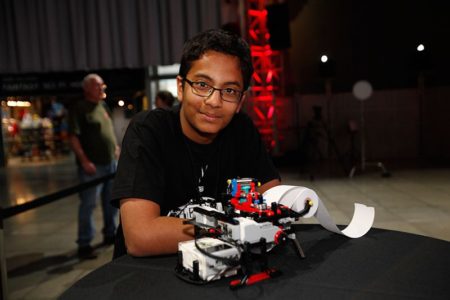
12-year-old Shubham Banerjee’s interest in Braille and Braille printers evolved out of his love for science. While doing research for an engineering project to enter for a science fair in January of 2014, he discovered that less than 10% of blind people can actually read Braille. This was, in part, due to the extremely high prices of Braille printers, costing around $2,000. Additionally, technological advancements such as the development of voice-to-text software significantly impacted the lives of the visually impaired. Banerjee realized that many visually impaired people were not able to afford the extremely expensive Braille printers, or the technology needed to efficiently communicate without one. Therefore, his new goal was to significantly reduce the cost of a Braille printer.
Banerjee worked for weeks to create a working prototype. After seven attempts, he finally successfully created a prototype using a Lego Mindstorms EV3 robotics kit and some small electrical components. Banerjee and his father, a software engineer, would often stay up until 2 a. m. working on the project together. At 13 years old, a high school freshman, Banerjee founded Braigo, the company name combining the words Braille and Lego. Braigo was a low-cost, portable printer and embosser that prints out raised bumps on paper. Banerjee also co-founded the company Braigo Labs to further develop the printer. Banerjee was faced with a lot of criticism and uncertainty because many Silicon Valley startups had tried to undertake the same project without success. He did not let this affect his work and research, however, and persevered through the difficult times. “Some [people] said that the market is not that big, or [that this is] a specialty product,” Banerjee says, unfazed. “I just went ahead with what I thought was right.”
The Braigo printed proved a success even while in its early stages. Banerjee entered his product into the 2014 Synopsis Science Fair and took home the top prize for a science or engineering breakthrough. It was also endorsed by Henry Wedler, a PhD candidate in organic chemistry who was honored by Barack Obama as a Champion of Change for his work leading a chemistry camp for visually impaired students. As Wedler puts it, “Inventors have been attempting to do what Shubham has done with Braille embossers for many years. Sometimes, it takes a young, fresh imagination and a will of iron to be truly innovative. This is the energy and quality that Shubham’s knowledge and passion as an inventor bring to Silicon Valley.” Banerjee and his company, Braigo Labs, managed to bring in venture capital to ensure the success of his company, becoming the youngest person ever to receive venture capitalist investment, according to CBS. Banerjee’s innovative spirit helped to better the lives of the visually impaired, while also encouraging and promoting others to follow in his footsteps.
To learn more about Shubham Banerjee and Braigo , click here.

The story of Shubham Banerjee is just so inspiring. At this tender age, he could identify the major problem and was committed to finding a solution. It is simply admirable that he just wanted to make Braille printers more affordable and accessible. His innovative thinking and resourcefulness are shown by using Lego Mindstorms EV3 kits to create working prototypes.
Undeterred by criticism and uncertainty, Banerjee forged ahead, and today he successfully founded Braigo and made a difference in the lives of visually challenged people. That is a story of determination and the fact that one should not give up on his or her passion, no matter how difficult the challenges ahead of him or her appear to be. It is pretty cool how such fascination with science and engineering brought such an innovative invention.
Wow! This is amazing! I have used a brailler before, but it takes a long time; you are typing on a typewriter-like machine with six keys (one for each braille cell). Kids mainly learn how to read braille in school by their TVI (teacher of the visually impaired). This machine would make their lives so much easier and make learning so much better. There are different ways these students learn math too, and this invention would increase accessibility and availability of the resources. Just think of how this would significantly improve the lives of the TVIs, where they can put time into more and different learning materials versus spending time just trying to figure out how to communicate with blind students. Also, just the fact that this was built from Legos is outstanding in demonstrating how innovation and solutions are literally at your fingertips.